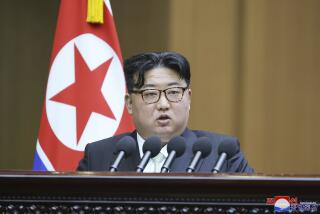On eve of historic Korean peace summit, high-stakes diplomacy stands front and center
Much of the first peace summit in a decade between the leaders of North and South Korea on Friday is scripted and rehearsed, even physically measured, and the dramatic imagery should capture the world’s attention.
Kim Jong Un, the grandson of North Korea’s communist patriarch, is expected to walk south across the border dividing the two countries to greet his counterpart, President Moon Jae-in — a historic and symbolic step between sister nations still technically at war.
The leaders will then meet on the South Korean side of Panmunjom, the tense military outpost along the demilitarized zone that has divided the countries for more than six decades.
The two leaders are then expected to meet over a glossy, oval negotiating table — specifically designed so they’ll be 2,018 millimeters (about 6½ feet) apart, representing the year.
How far the talks will go is less precise.
Up for discussion are three key issues: improving inter-Korean relations, which have been especially strained in recent years; establishing a sustainable agreement for peace on the peninsula, which could set a path to formally end the Korean War; and the potential denuclearization of the North, which spent last year inflaming the world by testing ballistic missiles and detonating an underground hydrogen bomb.
Now it’s left to Moon, a liberal human rights lawyer, and Kim, a third-generation dictator, to find common ground on these thorny issues, which are more immediate and intractable than those discussed during the previous two top-level summits between the two nations’ leaders in 2000 and 2007.
“That’s what makes tomorrow’s summit difficult,” Moon’s chief of staff, Im Jong-seok, acknowledged Thursday. “The most crucial part of the summit is solely left to the leaders tomorrow.”
The meeting comes after a flurry of diplomatic activity this year, sparked by the Winter Olympics, that could also lead to a historic meeting between Kim and President Trump — a first between the head of the North and a sitting U.S. president.
It also is occuring after the announcement of concessions from the North, a pariah state thought to possess 20 to 60 nuclear weapons and the theoretical ability to deliver them with intercontinental ballistic missiles capable of reaching the United States mainland.
In a remarkable move, the North said recently it is prepared to suspend its missile launches and close its main nuclear test site — and it also is said to have acknowledged the continuing presence of troops from the United States, a key South Korean ally, on the peninsula.
Steps toward a permanent peace agreement between the countries seem to be among the most likely results from the meetings, Korean experts say.
While far from a firm solution to a decades-long standoff between the Koreas, the meeting by Kim and Moon has the potential to set the stage for a deal that averts a war that, at times, seemed impossible amid the North’s provocations last year.
“We’ve been given a rare opportunity to ensure lasting peace on the Korean Peninsula,” Moon said this week, “while paving the way to sustainable improvement in inter-Korean relations.”
Moon’s statement bore some resemblance to one by his political mentor, the late former President Roh Moo-hyun, who made his own dramatic visit to North Korea for a summit with Kim’s late father, Kim Jong Il, in 2007.
“I now walk across this so-called forbidden line as South Korea’s president,” he said after slowly stepping across the yellow stripe marking the border. “And I hope it paves the road to peace and prosperity.”
Moon, then a presidential aide, stood in the background.
The relationship between the two nations has since deteriorated.
Since the younger Kim took power in late 2011, his nation’s nuclear and missile development has accelerated, ending a nascent nuclear agreement with the Obama administration and resulting in more international sanctions.
Given this history, Korea analysts have debated in recent days the significance and seriousness of the North’s diplomatic gestures.
But they do represent progress, however preliminary, ahead of what’s expected to be a landmark meeting between Kim and Trump, with South Korea helping lead the process diplomatically.
“They are road-testing a bunch of midrange concessions, which are actually pretty substantial,” said David Kang, an international relations professor at USC who heads the university’s Korean Studies Institute, said of the North.
The meeting between Moon and Kim — under the slogan “Peace, a New Start” — is expected to begin Friday morning, with the two leaders greeting at the border, known for decades as the Military Demarcation Line.
Kim is expected to step across the line, walk through a military honor guard, and then enter a building on the South Korean side designed for such meetings.
More than 800 journalists from across the globe have registered with South Korean officials to cover the event, parts of which are expected to be streamed live online — a surprising concession by the North, which maintains a closed stance regarding media and closely manages its official statements and imagery.
Kim’s willingness to enter South Korea — the first North Korean leader to do so — is a public symbol of how relations between the two countries have changed in recent years.
When Moon came to power in 2017, he ended a decade of hard-line presidential policies toward the North and pledged a fresh effort at dialogue. His overtures, including an invitation to the recent Winter Olympics in South Korea, were rebuffed by a series of missile tests that prompted international condemnation and economic sanctions.
But on New Year’s Day, in a speech in which he declared his nation a modern nuclear state, Kim also signaled a willingness to send a delegation to the Games. After talks between the North and South, the first in nearly two years, Kim agreed in January to send nearly two dozen athletes and a large group for cultural exchange and cheerleading.
The teams from the two nations — separated since World War II, though they share a common language and ethnic identity — agreed to march together under a unification flag. They also fielded the first integrated Korean team at any Olympics, a combined women’s hockey squad.
The developments have raised hopes and questions about a resolution to the long standoff, which has included other moments of diplomatic progress, but also deadly skirmishes, since the hostilities during the Korean War ended in 1953.
The North, isolated internationally but also newly confident because of its nuclear advancement, seems ready to seek deals to improve its economy, among the lowest per capita in the world, starting first perhaps with the South, which previously allowed cross-border business ventures.
Skepticism abounds among Korea experts, who cite many examples of failed agreements and hollow diplomatic overtures that have allowed the totalitarian state to become a nuclear-armed power.
Jung Pak, a former CIA analyst and now a senior fellow at the Brookings Institution’s Center for East Asia Policy Studies, said the steps by Kim aren’t yet credible. She said she believe the talks are just the beginning of a process toward potential peace, which will require coordination with other countries, such as the United States and China.
She, along with some other analysts, remains highly suspicious of the intentions in the North, a nation with an abysmal human rights record that has ignored international warnings and pressure about its nuclear program for years.
“It’s the miracle of low expectations. We have such little expectations of Kim Jong Un, and he’s so desensitized us to all the things that the regime is and does and the threat that it poses, that it’s a low bar for progress,” she said. “That’s one of the most dangerous things.”
Stiles is a special correspondent.
More to Read
Start your day right
Sign up for Essential California for news, features and recommendations from the L.A. Times and beyond in your inbox six days a week.
You may occasionally receive promotional content from the Los Angeles Times.







